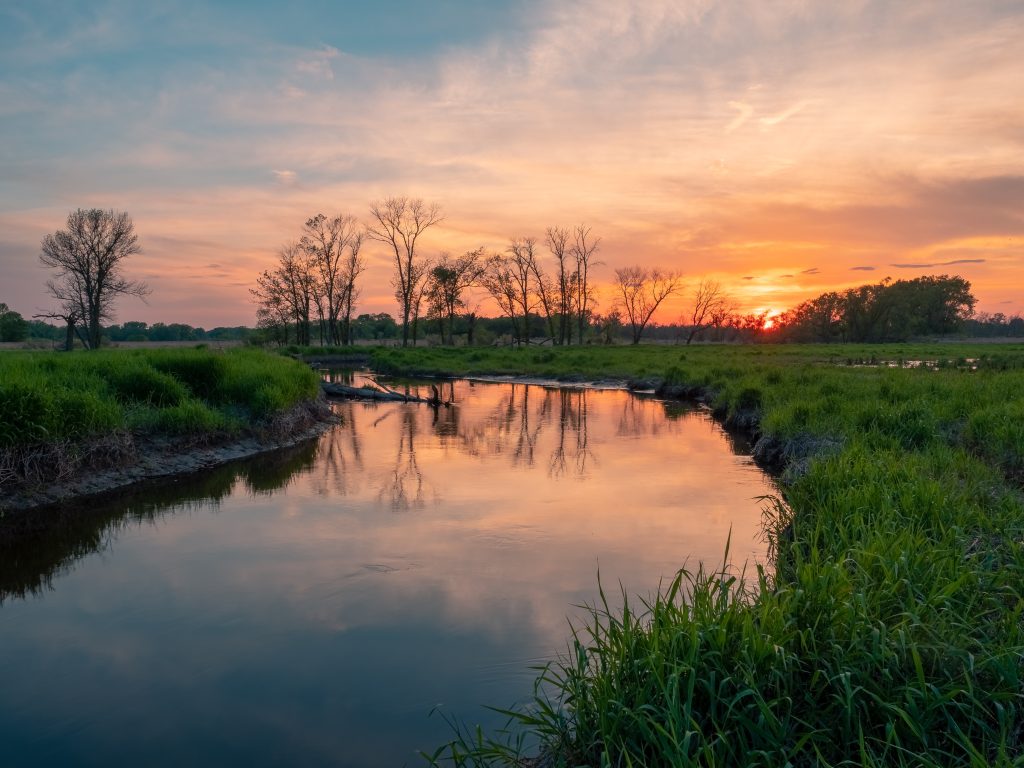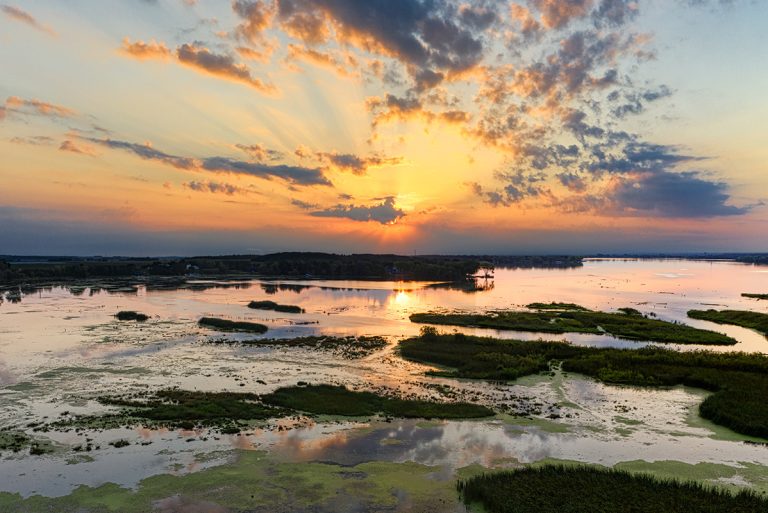When we preserve areas of our environment, critical ecosystems in a given area are protected and allowed to flourish. Our planet’s wetlands are a prime example of spaces that need to be protected. They are rich sources of biodiversity, with 40% of the world’s plant and animal species living and breeding in wetlands.
Approximately 35% of the world’s wetlands were lost between 1970 and 2015, mostly due to urban growth and development. For this reason, the process of wetland mitigation is critical to ensure that these areas do not remain desolate after a project takes place.
But what does wetland mitigation involve, and what are the benefits and downsides of this process? Let’s dive into all you need to know about wetland mitigation.
What are wetlands?
To understand the concept of wetland mitigation, it’s necessary to first know what spaces are defined as wetlands, and how they are classified.
The U.S. Environmental Protection Agency (EPA) defines wetlands as areas where water covers the soil, or is present either at or near the surface of the soil all year or for varying periods during the year, including during the growing season.
The hydrology, or water saturation, of these areas determines how the soil develops. It also determines the types of plant and animal communities that live in and on the soil.. There are generally two classifications for wetlands recognized by the EPA:
- Coastal/tidal wetlands: these wetlands are found along the oceans on the coast, and they are linked closely to the U.S.’s estuaries where sea water mixes with fresh water to form an environment of varying salinities.
- Inland/non-tidal wetlands: these wetlands are most often found along rivers and streams, along the margins of lakes and ponds, and in isolated depressions surrounded by dry land.
Whether tidal or non-tidal, there are four main types of wetlands that you’ve likely heard of, or at least come across before. These types are:
- Marshes: marshes are defined as wetlands frequently or continually inundated with water.
- Bogs: bogs are characterized by spongy peat deposits, acidic waters, and a floor covered by a thick carpet of moss.
- Fens: fens are peat-forming wetlands that typically receive nutrients from upslope sources through drainage from surrounding mineral soils and groundwater movement.
- Swamps: a swamp is any wetland dominated by woody plants.
Each type of swamp has its own essential function and values, but each is crucial for surrounding ecosystems to thrive.
However, like most of our environment, a variety of human activities can easily impact wetlands by altering their topography or hydrology. These activities can lead to the loss of the wetland habitat and negatively affect the surrounding ecosystem of plants and animals.

What is wetland mitigation?
Wetlands play a critical role in creating conditions that favor the growth of plants and soils, and support bird and animal species that can thrive off these foods. For this reason, protective measures are taken on a local, state, and federal level to protect these important regions.
Wetland mitigation refers to these steps that are put into place to restore, create, enhance, or replace the original state of wetlands.
Wetland mitigation is crucial to ensure that negative impacts resulting from projects near or on wetlands don’t obliterate these ecosystems. Legally, wetlands may be destroyed, but their loss must be compensated for by the restoration, creation, or enhancement of other wetlands, resulting in “no net loss” of wetlands.
So, what does the process entail?
The process requires the assessment of the impacts of a project or damage done to wetlands, and actions to be taken to mitigate these impacts either through replacement or restoration.
The ideal mitigation activities for wetland losses might include offsite or onsite enhancement, or in other cases, buying of credits. Individuals usually buy these credits from any permitted wetland mitigation bank.
Restoration of wetland areas is vital to restore and enhance the conditions of the affected ecosystems, whether it be rivers, estuaries, or springs. In various instances, wetlands act as buffers that safeguard wet and dry ecosystems by eliminating pollution before it reaches more fragile regions.
Development and growth in population are some of the main causes of environmental destruction like the damage that occurs in wetlands.
What is wetland mitigation banking?
Mitigation banking refers to the process of restoring, enhancing, or creating new wetlands, and it aims to compensate for the impacts on wetlands in a different location.
The process is primarily done to compensate for damage caused to wetlands due to developments nearby. However, it can also be undertaken for agricultural impacts to wetlands. Banks provide the option of purchasing credits to offset the unavoidable impacts of a project.
Mitigation banks occur in two categories: they include wetland mitigation banks and conservation mitigation banks.
Wetland mitigation banks provide the option of purchasing credits to offset the unavoidable impacts of a project on aquatic resources.
Conversely, conservation mitigation banks are built to offset losses that occur on habitats of threatened and endangered species, as well as other special-category species.
The Swampbuster Provisions, or section 404 of the Clean Water Act, protects the wetlands for the numerous benefits these regions offer. This program discourages farmers from altering wetlands by withholding Federal farm program benefits from any person who:
- Plants an agricultural commodity on a converted wetland that was converted by drainage, dredging, leveling, or any other means.
- Converts a wetland for the purpose of or to make agricultural commodity production possible.
Together with the Highly Erodible Land Conservation Program (HELC), wetland conservation also aims at reducing soil loss in areas prone to soil erosion.
These two provisions apply to all wetlands or any land that is highly erodible. They also impact land that is farmed or owned by an individual who voluntarily participates in USDA programs. Farmers must manage highly erodible land according to an approved conservation plan or conservation system which protects the land from water, wind, and gully erosion.
Those seeking to benefit from various USDA programs are required to be compliant with the conservation provisions by filling out a form known as AD-1026. The form helps to ascertain that these individuals will not dredge, drain, or fill wetlands as they look for places to grow their crops.
However, in certain situations where on-site prevention mitigation becomes a challenge, the Farm Bill permits for offsite mitigation, which is done through mitigation banking.

Source: Sara Cottle
How does mitigation banking work?
Now that we have a basic understanding of what mitigation banking entails, how does the process really work?
Producers are allowed to purchase credits from approved wetland mitigation banks, and these credits are meant to pay for the impacts resulting from lost wetlands.
Wetland mitigation banks are defined as a wetland, stream, or other aquatic resource area that has been restored, established, enhanced, or preserved for the purpose of providing compensation for unavoidable impacts to aquatic resources.
A mitigation bank is established by a government agency, corporation, nonprofit organization, or other entity that undertakes these activities under a formal agreement with a regulatory agency.
In the establishment of a mitigation bank, landowners retain both the ownership and use of the property. However, a conservation easement is established to protect any degradation activities on the wetlands.
The quantity of the available credits for sale depends on the scope and size of the wetlands’ restoration, enhancement, or creation. The seller and the buyer agree upon the prices of these credits.
How to develop mitigation banks
Bank sponsors are the ones who establish mitigation banks. But who is a bank sponsor?
A bank sponsor refers to any person or entity that establishes wetlands to be used in wetland mitigation banking. Bank sponsors cater to both the cost of developing the wetland and its long-term maintenance, which ensures that the wetlands remain functional well into the future.
Usually, mitigation credits are formulated through a functional appraisal procedure that assesses individual wetland functions. There are only a set amount of credits for sale, and ecological assessment techniques are required in order to certify that the credits compensate for the required ecological functions.
Every credit purchase is deducted from the mitigation bank, until there are no credits left. When all credits have been sold, the bank closes.
Mitigation banks are comprised of four separate components, including:
The bank site
The bank site refers to the physical acreage or land which has been established, preserved, restored, or enhanced.
One prospective source of space to use for wetland mitigation banks is the land from wetland practices registered in USDA’s Conservation Reserve Program (CRP). The National Food Security Act Manual permits the use of CRP land for wetland mitigation after the expiration of the CRP contract.
The bank instrument
The bank instrument is the formal contract between the bank owners and regulatory agencies, which establishes liability, management, monitoring needs, performance standards, and the terms of credit approval by the bank.
The IRT (Interagency Review Team)
The IRT is the team that offers services such as regulatory review, approvals, and the bank’s oversight.
The service area
The service area refers to a geographic region in which mitigation credits can be used to compensate for impacts on wetlands. However, these impacts must be permitted, and the credits must be purchased at a particular mitigation bank.
Wetland restoration definitions
Aside from coastal and inland wetlands, the process of wetland mitigation involves a few more frequently used definitions.
Let’s look at the difference between restored, enhanced, and created wetlands.
Restored wetlands
Restored wetlands refer to when the land is mostly reverted to its former state through an adjustment in hydrology. However, the restoration of wetlands can fall into a few different categories, as defined by the EPA.
There are three most common types of restoration-related activities: creation, reallocation, and enhancement. They are similar to restoration, but differ in their processes.
Reallocated wetlands
When most, or all, of an existing wetland is converted to a different type of wetland, it has been reallocated.
One example of this type of restoration would be when an emergent wetland is converted into a pond. In doing so, one type is converted into another type of wetland, fundamentally changing its function.
Enhanced wetlands
Enhancement refers to the modification of one or more structural features of an existing wetland. One example of enhancement is increasing the depth of the water to better support the growth of plants and wildlife.
Wetland enhancement is always done to improve the space, whether it creates new positive conditions or enhances current aspects of the wetland.
It’s important to note, however, that a positive change in one wetland function may negatively affect other wetland functions. This is why these alterations can often be more costly to produce and maintain in comparison to restored wetlands.
Created wetlands
Created wetlands are typically developed in areas where there were no wetlands previously. For this reason, a more elaborate architectural design is necessary, as well as fitting of structures and water pumps.
Fundamentally, created wetlands are placed in an area by some form of human activity. They are typically created to support wetland species’ growth by establishing the correct hydrology.
What is a wetland mitigation credit?
Wetland mitigation credits, also known as stream mitigation credits, are units of trade which aim to compensate for the ecological losses occurring in U.S. waters. Both the EPA and the Army Corps of Engineers control the credits.
These credits require an individual to meet their environmental mitigation permit requirements before they can impact waters or wetlands.
In the past, mitigation banks were built to help compensate for effects caused on various types of wetlands, but they can now be used to cater to particular effects on streams as well.
In the U.S., the ACE and EPA are the bodies responsible for regulating and approving impacts that occur on aquatic resources.
On the other hand, the U.S. Fish and Wildlife Service (USFWS) and U.S. National Marine Fisheries Service (NMFS) are responsible for the control and approval of impacts that occur on habitats of listed species.
These four federal agencies help to determine the ideal form and amount of compensation for ecological losses.
When developing mitigation banks, all these agencies must be involved and they must review and approve the ecological evaluation techniques. This is done to ascertain that the mitigation credits provided offer the necessary environmental functions to compensate for the impacts.
The pros and cons of wetland mitigation banking
Since the first wetland mitigation project that took place in the 1980s, wetland mitigation banking has gained much popularity.
However, multiple agencies are now shifting from case-by-case wetland mitigation to relying on mitigation banking. This is the restoration, enhancement, or creation of new wetlands prior to a proposed development that will destroy a wetland.
In this scenario, individuals or companies can buy mitigation credits from mitigation banks, as opposed to working through the lengthy process of permitting and mitigation.
The pros of wetland mitigation banking include:
- The wetlands are usually larger.
- They are developed before the destruction can take place on a wetland, allowing them to serve as natural wetlands sooner.
- Money and time is saved through the consolidation of mitigation efforts for several projects.
- The process helps to establish self-supporting wetlands that are environmentally equivalent to the impacted sites.
- The process can lead to the appreciation of the land, especially if private developers want to use it.
The cons of wetland mitigation banking include:
- The process comprises a higher loss of smaller, more remote wetlands that serve a vital purpose in their ecosystems.
- Wetland mitigation banking can lead to reduced wetland area overall and in a certain watershed.
- Even with the most articulate planning and consideration, the negative impacts on wetlands and streams are sometimes inevitable. Increased development resulting from rapid urban growth requires more and more natural spaces.
- Although mitigation banking can be potentially profitable, it comes with numerous costs, especially in the review and approval process.
Mitigation banking and land use
When it comes to the selection of sites for wetland mitigation banks, the only sites that qualify include restored, created, or enhanced wetlands. The preservation of current wetlands does not qualify for this process, because it does not offer additional acres of wetlands.
So, what type of land is the best for wetland mitigation banking? There’s a few.
- Generally, previous wetlands that have been restored to their original state offer the best possibility for success in improving wetland values and functions.
- After the restored wetlands, enhanced wetlands are second best in providing optimal success opportunities.
- Lastly is the creation of wetland in an area that has never been home to a wetlands.
When choosing a site, it’s vital to consider the area’s stability, as the bank sponsor must provide long-term maintenance of the site. This helps to ensure that the new wetland remains functional and thrives.
Final thoughts on wetland mitigation
The protection of our planet’s ecosystems is undeniably one of the best things we can do for future generations. Wetland mitigation is just one of the various ways we can ensure that our wetlands and the habitats for listed species are protected.
If you wish to learn more about how to develop a wetland mitigation plan, you can visit the Interagency wetland mitigation guidance for more information.
Green Coast is a renewable energy and green living community focused on helping others live a better, more sustainable life.












